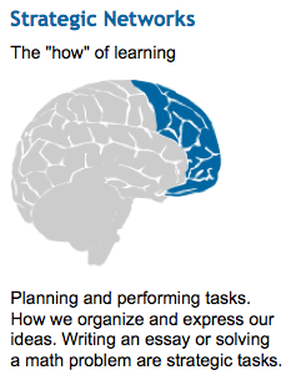Strategic Networks

It is through strategic networks that we plan, execute, and monitor our internally generated mental and motor patterns-actions and skills as diverse as sweeping the floor, deciding a chess move, or choosing a college. During some activities, such as playing sports, orchestrating an April Fool’s joke, or composing an essay, we may be conscious of applying strategy. What most of us do not realize is that conscious or not, strategy is involved in essentially everything we do. Strategic networks are specialized to generate and oversee mental and motor patterns. They enable us to plan, execute, and monitor actions and skills.
“Differences in strategic networks manifest themselves in various ways in the classroom. For example, learners differ dramatically in their abilities to acquire and automate pattern-based routines such as forming letters, typing, spelling, and multiplying. Learners also differ in their ability to enact higher-level strategies such as planning, organizing, monitoring progress, devising alternative approaches, and seeking help when they need it. For example, students with executive-function disorders (disorders affecting reasoning, logic, hypothesis-testing, and similar high-level abilities) can have difficulty at all levels of reading. When decoding words, they may make impulsive guesses rather than apply their phonics knowledge or search for context cues. When reading a paragraph, they may fail to use organizing strategies to help them focus on the key points.”
Source: http://www.cast.org/teachingeverystudent/ideas/tes/chapter2_5.cfm
“Differences in strategic networks manifest themselves in various ways in the classroom. For example, learners differ dramatically in their abilities to acquire and automate pattern-based routines such as forming letters, typing, spelling, and multiplying. Learners also differ in their ability to enact higher-level strategies such as planning, organizing, monitoring progress, devising alternative approaches, and seeking help when they need it. For example, students with executive-function disorders (disorders affecting reasoning, logic, hypothesis-testing, and similar high-level abilities) can have difficulty at all levels of reading. When decoding words, they may make impulsive guesses rather than apply their phonics knowledge or search for context cues. When reading a paragraph, they may fail to use organizing strategies to help them focus on the key points.”
Source: http://www.cast.org/teachingeverystudent/ideas/tes/chapter2_5.cfm
Make your own slide show at Animoto.
Understanding the relationship between the UDL principles and the three neural networks
Use the BrainNetworks_handout and use it to take notes as you learn about each of the brain networks.
OR
Use the Google Doc: BrainNetworks
Select the following link to the CAST online module and read about strategic networks. Continue to the next page “Classroom Examples: Differences in Strategy” to review classroom applications of the strategic network. Read about strategic networks then continue to the next page “Classroom Examples: Differences in Recognition” to review classroom applications of the recognition network.
Discussion Questions:
OR
Use the Google Doc: BrainNetworks
Select the following link to the CAST online module and read about strategic networks. Continue to the next page “Classroom Examples: Differences in Strategy” to review classroom applications of the strategic network. Read about strategic networks then continue to the next page “Classroom Examples: Differences in Recognition” to review classroom applications of the recognition network.
Discussion Questions:
- What do strategic networks enable us to do?
- What is the affect of individual differences on strategic networks?
- What are the implications of this information for teaching and learning in your classroom?